初一英语下学期unit6period5新目标
新目标英语七年级下册第五单元第一课时说课稿
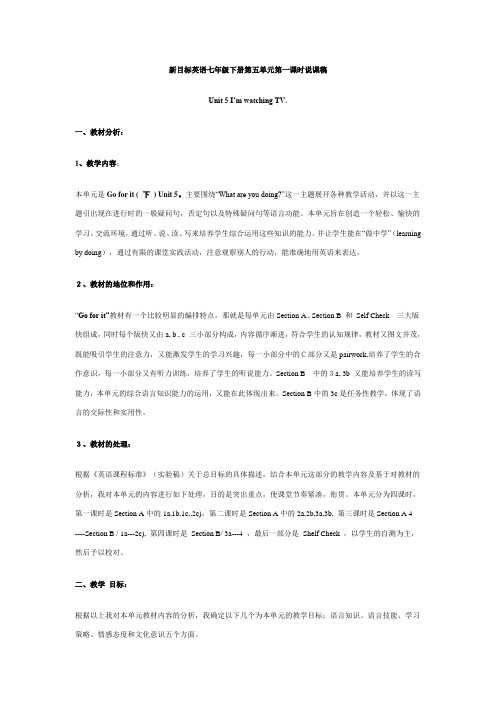
新目标英语七年级下册第五单元第一课时说课稿Unit 5 I’m watching TV.一、教材分析:1、教学内容:本单元是Go for it (下) Unit 5。
主要围绕“What are you doing?”这一主题展开各种教学活动,并以这一主题引出现在进行时的一般疑问句,否定句以及特殊疑问句等语言功能。
本单元旨在创造一个轻松、愉快的学习、交流环境,通过听、说、读、写来培养学生综合运用这些知识的能力。
并让学生能在“做中学”(learning by doing),通过有限的课堂实践活动,注意观察别人的行动,能准确地用英语来表达。
2、教材的地位和作用:“Go for it”教材有一个比较明显的编排特点,那就是每单元由Section A , Section B 和Self Check三大版快组成,同时每个版快又由a, b , c 三小部分构成,内容循序渐进,符合学生的认知规律,教材又图文并茂,既能吸引学生的注意力,又能激发学生的学习兴趣,每一小部分中的C部分又是pairwork,培养了学生的合作意识,每一小部分又有听力训练,培养了学生的听说能力。
Section B中的3a, 3b 又能培养学生的读写能力,本单元的综合语言知识能力的运用,又能在此体现出来。
Section B中的3c是任务性教学,体现了语言的交际性和实用性。
3、教材的处理:根据《英语课程标准》(实验稿)关于总目标的具体描述,结合本单元这部分的教学内容及基于对教材的分析,我对本单元的内容进行如下处理,目的是突出重点,使课堂节奏紧凑,衔贯。
本单元分为四课时,第一课时是Section A中的1a,1b,1c,,2c),第二课时是Section A中的2a,2b,3a,3b, 第三课时是Section A 4----Section B / 1a---2c), 第四课时是Section B/ 3a---4 ,最后一部分是Shelf Check ,以学生的自测为主,然后予以校对。
新目标初一下unit6课件

3b Bring in some photos of your own (or draw some pictures of you and your family or friends) and write about them.
今天是星期天,天气很好。海滩上真热闹, 有很多人正在休闲。请你根据下画写一篇 文章,描述一下人们正在做些什么。 提示词:be doing, there be, surf, play beach volleyball, build sand castles, take pictures, relax, walk a dog…(后附范文)
Ukraine 9:45 p.m.
Beijing 2:45 a.m.
Sochi 4:00 p.m. Beijing 8:00 p.m.
Activity 1: Have you ever been to another country before? Do you have any stories about jet lag(时差)? Please share with you group members. Activity 2: Make a telephone call and ask what each other is doing in pairs. Student A and Student B are in two different places in the world.
1c Listen and complete the chart.
Names Alice Mike Lisa Places supermarket Activities
1d Listen again. Check your answers in 1c.
新目标英语七年级下unit6全单元课件

Students listen to a passage with missing information and fill in the missing information based on what they hear. This exercise helps them understand the overall meaning while focusing on specific details.
vocabulary.
02
Reading comprehension
The courseware provides reading materials with questions and
exercises to help students understand and apply the theme
Inferring
Drawing inferences and conclusions from the text, beyond what is explicitly stated.
Critiquing
Evaluating the credibility, accuracy, and fairness of the
01
Unit Introduction
Unit Theme
The unit theme is "Festivals and Celebrations". It focuses on different festivals and celebrations around the world, including traditional and modern festivals.
information presented in a text.
人教新目标七年级英语下册导学案Unit6-5
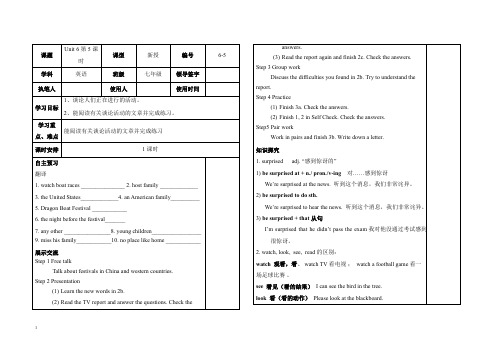
课题Unit 6第5课时课型新授编号6-5学科英语班级七年级领导签字执笔人使用人使用时间学习目标1、谈论人们正在进行的活动。
2、能阅读有关谈论活动的文章并完成练习。
学习重点、难点能阅读有关谈论活动的文章并完成练习课时安排1课时自主预习翻译1. watch boat races _______________2. host family _____________3. the United States_____________4. an American family__________5. Dragon Boat Festival ____________6. the night before the festival_______7. any other ________________8. young children_________________ 9. miss his family____________10. no place like home ____________ 展示交流Step 1 Free talkTalk about festivals in China and western countries.Step 2 Presentation(1)Learn the new words in 2b.(2)Read the TV report and answer the questions. Check theanswers.(3)Read the report again and finish 2c. Check the answers. Step 3 Group workDiscuss the difficulties you found in 2b. Try to understand the report.Step 4 Practice(1)Finish 3a. Check the answers.(2)Finish 1, 2 in Self Check. Check the answers.Step5 Pair workWork in pairs and finish 3b. Write down a letter.知识探究1. surprised adj. “感到惊讶的”1) be surprised at + n./ pron./v-ing 对……感到惊讶We’re surprised at the news. 听到这个消息,我们非常诧异。
人教新目标英语七年级下Unit6

新目标英语七年级下Unit 6 It ' s raining !Section A Period 1审核人:宋成建备课时间:第三周拟使用时间:第四周星期一教师寄语:First think and then speak.先思后说)学习目标:1. 学习P31-P33新单词及短语;2. 灵活运用本课的重点句型How' s the weatherlt ' s raining.3. 通过自主学习,合作学习等学习策略,训练学生的逻辑思维,快速反应能力和实践能力,使学生熟练运用英语表达天气情况。
前置测评:听写本课的单词及短语。
认定目标:师生共同认定。
自主探究:1>听录音,学习新单词及短语;2、学生看P31 1a,将词语与图片匹配;学生独立完成,然后小组交流,并展示答案。
师评析。
3、1b听录音,将城市名填在方框内;听后独立完成,然后小组交流,展示答案。
师评析。
4、1c结对活动:师生评价,选出活动较好的小组。
5、学生看P32 2a,听对话,学生先独立完成,然后小组交流,展示答案。
师评析。
6、学生看2b,再听一遍录音,学生先独立完成,然后小组交流,展示答案。
师评析。
7、结对活动2c:小组成员交替扮演角色练习对话,小组展示,师生评价,选出活动较好的小组。
题组训练:按要求写单词。
1. sun (形容词)_______2. take (-ing形式)________3.join (单数第三人称)__________4. windy (名词形式) _____5. music音乐家)___________6. lie (-in影式) _______7. boring原义词)_______8. cold犀义词)_ 归纳总结:学生总结本节课的重点内容:达标测评:一、会话配对。
新目标英语七年级下Unit 6 It ' s raining !)1. Do you like cold weather? )3. What are you doing? )4. How ' s it going? )5. How do you spell、句型转换,一空一词。
【人教版】新目标七年级下册英语:Unit 5教案
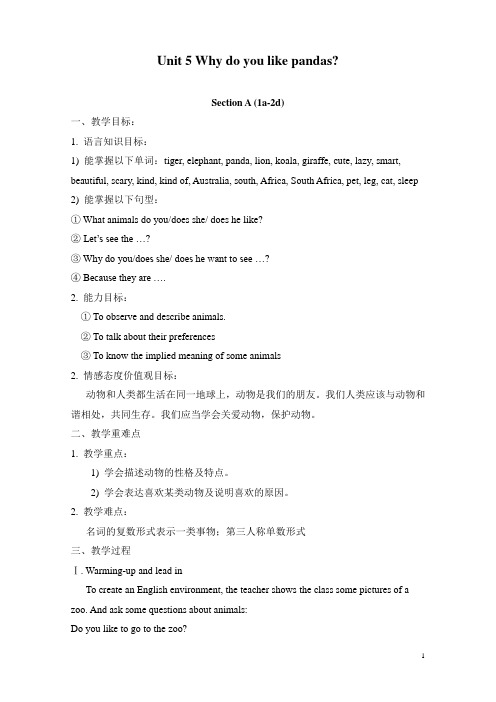
Unit 5 Why do you like pandas?Section A (1a-2d)一、教学目标:1. 语言知识目标:1) 能掌握以下单词:tiger, elephant, panda, lion, koala, giraffe, cute, lazy, smart, beautiful, scary, kind, kind of, Australia, south, Africa, South Africa, pet, leg, cat, sleep2) 能掌握以下句型:① What animals do you/does she/ does he like?②Let’s see the …?③Why do you/does she/ does he want to see …?④Because they are ….2. 能力目标:① To observe and describe animals.② To talk about their preferences③ To know the implied meaning of some animals2. 情感态度价值观目标:动物和人类都生活在同一地球上,动物是我们的朋友。
我们人类应该与动物和谐相处,共同生存。
我们应当学会关爱动物,保护动物。
二、教学重难点1. 教学重点:1) 学会描述动物的性格及特点。
2) 学会表达喜欢某类动物及说明喜欢的原因。
2. 教学难点:名词的复数形式表示一类事物;第三人称单数形式三、教学过程Ⅰ. Warming-up and lead inTo create an English environment, the teacher shows the class some pictures of a zoo. And ask some questions about animals:Do you like to go to the zoo?Do you like animals?Then have them to recall the animals they had learned and write them on the blackboard as he/she can.( e.g. animals,sheep, monkey, cat, dog, mouse, cow, duck… )Ⅱ. Presentation1. Ask them to talk with their partners about the animals they like using the words they know (Four students a group).—What animals do you like?—Why do you like…—Because they’re…2. Then show the class some pictures of animals and present other animals. And ask them:What’s this in English?It's a tiger. (Then lion, panda, elephant, koala, giraffe)Ss look at the picture and try to remember the new words of the animals.3. Next, glue the pictures on the blackboard and ask one student to match the pictures with the words on the cards. Other students turn to page 25 and finish 1a.4. Check the answers with the class.Ⅲ. Game (Guessing game.)T: Show some pictures on the big screen. Let Ss guess what animal it is.Ss try to guess and remember the names of the animals.Ⅳ. ListeningWork on 1b.Tell Ss to listen to the tape and check the animals they hear in 1a.Play the recording again and check the answers with the class.Ⅴ. Pair work1. Ask the students to imagine “ We are in the zoo, there are many kinds of animals here.”Then ask a student to do the model with you:—Let’s see the lions first.—Why? (why do you /does she /does he like lions?)—Because they are interesting.2. Ss work with their partners practice the conversation using the animal in 1a.Ⅵ. Listening1. Work on 2a;T: Listen to the conversation carefully. Then write the names of the animals you hear on these lines.Play the recording the first time. Students only listen.Play the recording a second time. This time students write in the names of the animals. Check the answers.Point out the adjectives and countries listed on the right. Ask a student to say the words. Say, Now I will play the recording again. This time draw a line between each animal and the adjective and countries you hear.Play the recording and have students match each animal with an adjective and a country. Correct the answers.2. Work on 2bT: Listen again and complete the conversation with the words in 2a.Play the recording for the Ss to listen and write the answers.Check the answers with the class.Ⅶ. Pair work1. Ask two students to read the conversation in 2b to the class.2. Ss practice the conversation in pairs.3. Then show the transcription on the big screen and practice the other two conversations in 2a.4. Ss practice the conversations in pairs.Ⅷ. Role-play1. Ask Ss to look at the picture in 2d. Then Ss read the conversation in 2d and find the answers to the questions:① Does Peter have a pet?② What can Dingding do?③What pet does Jenny’s mom have?④ Does Jenny like the cat? Why?2. Ss read the conversations and try to find the answers to the questions.Check the answers:Yes, he does.He can walk on two legs. He can dance, too.She has a cat.No, she doesn’t. Because it’s very lazy.3. Ss work in pairs and practice the conversation.4. Let some pairs role-play the conversation.Homework:1. Remember the new words and expressions in this period.2. Role-play the conversation after class.3. Write the animal's names as many as possible in the exercises book.板书设计:Section A (Grammar Focus-3c)一、教学目标:1. 语言知识目标:1) 继续练习运用如何做描述动物及表述自己对动物的喜好。
人教版英语教材七年级下册unit6教案
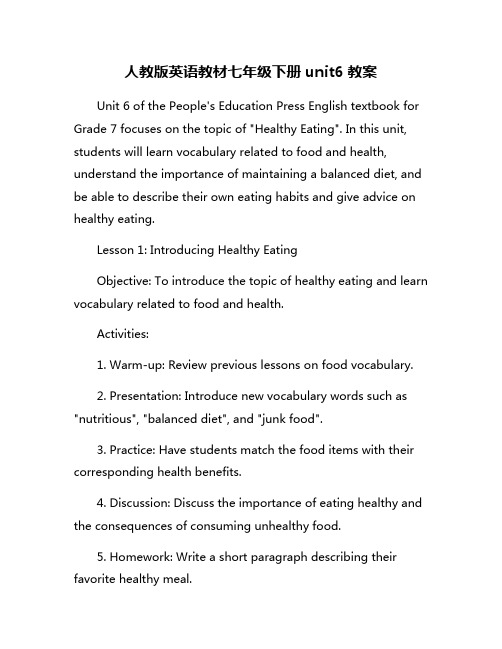
人教版英语教材七年级下册unit6教案Unit 6 of the People's Education Press English textbook for Grade 7 focuses on the topic of "Healthy Eating". In this unit, students will learn vocabulary related to food and health, understand the importance of maintaining a balanced diet, and be able to describe their own eating habits and give advice on healthy eating.Lesson 1: Introducing Healthy EatingObjective: To introduce the topic of healthy eating and learn vocabulary related to food and health.Activities:1. Warm-up: Review previous lessons on food vocabulary.2. Presentation: Introduce new vocabulary words such as "nutritious", "balanced diet", and "junk food".3. Practice: Have students match the food items with their corresponding health benefits.4. Discussion: Discuss the importance of eating healthy and the consequences of consuming unhealthy food.5. Homework: Write a short paragraph describing their favorite healthy meal.Lesson 2: My Eating HabitsObjective: To describe personal eating habits and understand the importance of a balanced diet.Activities:1. Warm-up: Review vocabulary words from the previous lesson.2. Speaking Practice: Have students describe their eating habits using the new vocabulary words.3. Role-play: Divide students into pairs and have them role-play a conversation about their eating habits.4. Reading Comprehension: Read a passage about the benefits of a balanced diet and answer comprehension questions.5. Homework: Write a diary entry about what they ate in a day and reflect on whether it was a healthy choice.Lesson 3: Giving Advice on Healthy EatingObjective: To give advice on healthy eating habits and understand the importance of making good food choices.Activities:1. Warm-up: Review vocabulary words from previous lessons.2. Vocabulary Practice: Have students create sentences using the new vocabulary words.3. Pair Work: Divide students into pairs and have them give advice to each other on how to maintain a healthy diet.4. Writing Exercise: Write a letter to a friend giving them advice on healthy eating.5. Role-play: Have students role-play a scenario where they are giving advice to a friend who is struggling with their diet.Overall, Unit 6 of the Grade 7 English textbook is designed to teach students the importance of healthy eating habits and provide them with the vocabulary and skills to make informed choices about their diet. By the end of this unit, students should be able to describe their own eating habits, give advice on healthy eating, and understand the benefits of maintaining a balanced diet.。
人教版新目标七年级下册Unit 6 分课时课文听力+翻译
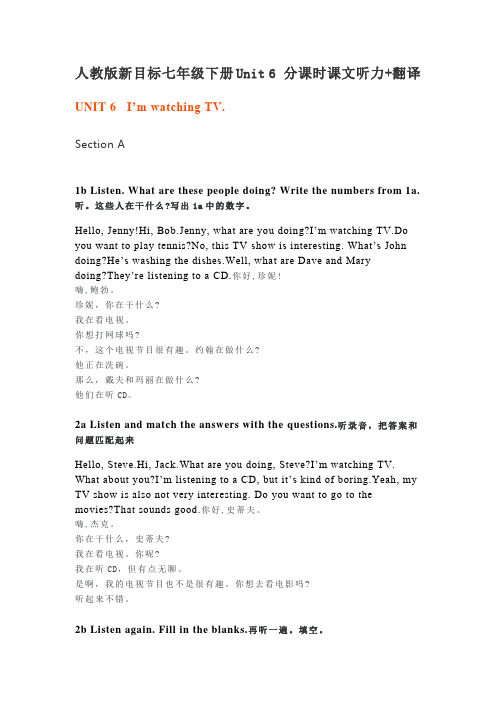
人教版新目标七年级下册Unit 6 分课时课文听力+翻译UNIT 6 I’m watching TV.Section A1b Listen. What are these people doing? Write the numbers from 1a.听。
这些人在干什么?写出1a中的数字。
Hello, Jenny!Hi, Bob.Jenny, what are you doing?I’m watching TV.Do you want to play tennis?No, this TV show is interesting. What’s John doing?He’s washing the dishes.Well, what are Dave and Marydoing?They’re listening to a CD.你好,珍妮!嗨,鲍勃。
珍妮,你在干什么?我在看电视。
你想打网球吗?不,这个电视节目很有趣。
约翰在做什么?他正在洗碗。
那么,戴夫和玛丽在做什么?他们在听CD。
2a Listen and match the answers with the questions.听录音,把答案和问题匹配起来Hello, Steve.Hi, Jack.What are you doing, Steve?I’m watching TV. What about you?I’m listening to a CD, but it’s kind of boring.Yeah, my TV show is also not very interesting. Do you want to go to the movies?That sounds good.你好,史蒂夫。
嗨,杰克。
你在干什么,史蒂夫?我在看电视。
你呢?我在听CD,但有点无聊。
是啊,我的电视节目也不是很有趣。
你想去看电影吗?听起来不错。
2b Listen again. Fill in the blanks.再听一遍。
新目标英语七年级下unit6全单元课件

在此添加您的文本16字
听力策略指导
在此添加您的文本16字
指导学生制定适合自己的听力计划和策略,如定期进行听 力训练、选择合适的听力材料、采用多种练习方式等。
在此添加您的文本16字
鼓励学生在实际学习中不断调整和完善自己的听力策略。
Listening exercises and consolidation
Speaking
The courseware includes speaking activities designed to develop students' speaking skills.
Reading
Writing
The courseware provides reading materials to enhance students' reading comprehension and vocabulary knowledge.
In Lesson 1, students will learn about the importance of festivals and celebrations in different cultures.
In Lesson 2, they will Lesson 3 will focus on
The theme aims to introduce students to different cultures and customs, enhance their understanding of the world, and promote intercultural communication.
The courseware includes writing tasks that aim to improve students' writing skills and grammar usage.
新目标英语七年级下Unit 6全单元课件

Overview of Unit Content
Theme
This unit focuses on the theme of "Festivals and Celebrations".
Materials
The unit uses a variety of materials, including texts, videos, audio
Future
perfect
tense of "to have"
Future continuous tense of "to be"
Grammar point parsing
Passive voice Subjunctive mood
Application scenarios of vocabulary and grammar
05
reading comprehension
Analysis of Reading Materials
01
The reading materials are selected from authentic English sources, including newspapers, magazines, and online articles, to provide students with a variety of reading experiences.
新目标英语七年级下册unit6课件

06
reading comprehension
Reading materials
选择合适的阅读材料
为了提高学生的阅读理解能力,教师需要选择适合学生水平 的阅读材料。这些材料应该具有多样性,包括故事、科普文 章、新闻报道等,以激发学生的学习兴趣和拓宽他们的阅读 视野。
注重材料的真实性
选择真实、地道的英语阅读材料,如原版的英文小说、报纸 、杂志等,有助于学生接触到原汁原味的英语,提高他们的 语言感知能力和阅读理解能力。
01
Course Introduction
Course objectives
• Language knowledge:Students will be able to understand and use key vocabulary and grammar structures related to the topic of “Festivals and Celebrations”.
Listening exer式
设计多种形式的听力练习,如填空、选择、判断 正误等,以提高学生的参与度和听力训练效果。
注重实际应用
将听力练习与实际生活情境相结合,如模拟真实 对话、角色扮演等,以增强学生的实际应用能力。
3
及时反馈和评估
对学生的听力练习进行及时反馈和评估,指出存 在的问题和不足之处,并提供有针对性的指导和 建议。
观点与态度
学生需要理解文本中表达的观点和态度,例如对不同职业的评价和看法。这将有助于他们 形成自己的职业规划和人生目标。
Text Organization
段落结构
学生需要分析文本的段落结构, 了解段落之间的逻辑关系和组织 方式。这将有助于他们理解文本
新目标七年级英语下册全册Unit 6英文教案
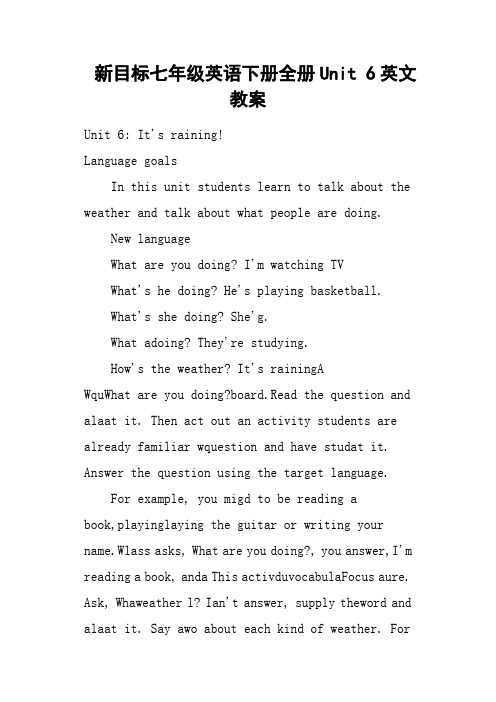
新目标七年级英语下册全册Unit 6英文教案Unit 6: It's raining!Language goalsIn this unit students learn to talk about the weather and talk about what people are doing.New languageWhat are you doing? I'm watching TVWhat's he doing? He's playing basketball.What's she doing? She'g.What adoing? They're studying.How's the weather? It's rainingAWquWhat are you doing?board.Read the question and alaat it. Then act out an activity students are already familiar wquestion and have studat it. Answer the question using the target language.For example, you migd to be reading abook,playinglaying the guitar or writing your name.Wlass asks, What are you doing?, you answer,I'm reading a book, anda This activduvocabulaFocus aure. Ask, Whaweather l? Ian't answer, supply theword and alaat it. Say awo about each kind of weather. Forexample, It's raining.Is it rainingday?Point out the numbered list of words. Say each one and ask studat the words agaThen ask studatch each word wure. Say, Wlaxvords. Point out the sample answanswb This activity gives students praunderstanding the target languagversaPladingudents only listen.Say, You will hear four dversaaabout the weaa dPaure auaPlading a second time. Ask studwauweather. Say, Tas been du. Beijing is wure of sunny weather. It is sunny in BeijinganswThis activity provides guided oral practice using the target language.Point out the example conversation. Ask two studad the dialogulaay, Now work with a paake your own conversations about the weave plaAs the pairs talk, move aroundg their wlanguagunciation support as needed.Ask several paversala2a This activity gives students praunderstanding the target languagversaPur pictures. Ask studll what eadoing in each picture. For example, This boy is talkingThis man is playing basketball. Supply vocabulary wordsas needed.Pladingudents only lPlading a second time. Task studlding and numbuugw what eadoingansw2b This activity provides listening practice using the target language.Point out the lames and the list of activities.Ask a dudad each llaay, Now I will plading again. Tlease match each name with an activity. Wlan activach name. Point out the sample answumbPlading and have students fillanswansw2c This activity provides guided oral practice using the target languagall aur peoplure in activity 2a. Ask studag about eaGuide studuse the words and phrases playing basketballg, ivatching TV, and playing computer gaPoint out the sample conversabubbles and have a paudents readlaay, Now please work with a paake conversations lTalk aboulI pictures. As students wairs, move aroundg progress andg assistaded.Aaversalaa This activduvocabulaall aaces. Ask studand describe each face using whatever vocabulaan.Help studdw ealing. For example, ask a student. Look aace. Is it happy? Is it unhappy?Tur words. Say the words and ask studat eaUse youvoice and facial exaning of each. Add your own simple explanawhat eaans.For example: Not bad. This meagvery good, but it's also not very bad. It'ddle. After that, ask studatch each numbered phrase with a face by writing the lach fablaase.As students work, move aroundansweringquas neededanswb This activity provides oral practice using the target language.Point ouversalarge picture and ask two studadlass. Ask studxplain what How's it going? means. (Ilar to How are you? or How is everything?) Ask studaversaairs.Move aroundggThen call axamplallbubbles. Have two students readlaay, Now we'll changwords and make our own conversations. We can use our own names. We can give true answers or we can make up answAsk paudake uwn conversave aroundg language support as needed.Aaversalass.4. This game provides oral practice using the target languagay,Now let's wairs agaudent looks aure on page 85 andlooks aure on page 87. Please don't lookat your part ner's pictuay, Each picture has the same peoplbut they are doing dgs. Take turns talking about whale are doing in your picture. If I am student A, I will say. Iuunny. Guidudents Bd. Iuaining.As students work, move aroundg progress andg assistance as neededBNew languagwords used to describe weather:coldl, warm, humidAdditional materials to bring to class:weather map from an English language newspaa This activduvocabulaFocus ave pictures. Ask studll what the wealach plaan. Iupply the word and alaat it. Say awo about each kind of weather. It's coldure. Is it coldday?Point out the numbered list of words. Say each one and ask studat the words agaThen ask studatch each word wures. Say, Wlach picture nexwords. Point out the sample answanswb This activity provides oral practice using the target language.Call axamplbubbles.Readversation with a studAsk studwairs. Have students ask and answer quabout the weaures in activity la.2a This activity provides listening and writing practice using the target language.Read the headingalass. Point out the answer blaay, Lversation between Sam and Maria. Listen carefullquand answPlay the taudents only listen. Play the tape again and have students wanswPlay the tape again and have students wanswers. Say, Tlease wanswers Maria and Sam givquHow's it going?"You may wlay the taan once aansw2b This activity providlistening and writing practice using the target language.Pand readd two headingart: What are you doing? How's the weather?Ask studlding again and wanswwo qublaaPlading. Students fillblaansw2c This activity provides guided listening and speaking I practice using the target language.Point out the examplbubbles. Ask two studadlaPoint ouqu2a. Ask individual students each question and repeaanswers. Accept any reasonable answay, Now work with a paake your own conversaudent A is Maria. Student B is Sam. Athey talk, move aroundgtheir wlanguage support as needed.3a This activity provides reading practice using the target languagall abubble andure.Ask studay wAll whaw about EgReadbubbllass, or ask a student to do so. Answer any quudents may have. Use drawingboard and/or translalaanings of any new vocabulary words. Ask studwork alone. Say, Underlwordbubble that say what people are doing. Tle the words that describe the weather. Two examples are du.3b This activity provides reading and writing practice using the target language.Draw aures of France and the dbelow. Read the dlass or ask a student to do so. Say the word blank eaua blank lAnswer any quudents may have abouw words. Use drawingboard and/or translalaanings of any new vocabulary words.Ask studwork alone. Have students fillblanks. Point out the sample answer and read thaanswThis activity provides writing practice using the target language.Awo studdescribe the weawn, and to say what outdoor activllike to do (e.g. playing football,flyingg).Ask studwork alone. As they work, move around the clag progress andg help aary. Providudents with any new vocabulad (e.g. for describingactivities)uraguse a dictionaAsk several studadlaThis survey provides listening, speaking, and writing practice using the target languagall adialogububbles.Ask two studadlass. Audents,What do you do when it's raining?Substitute aweaaining" and audents what they do. Accept all reasonable answers and write eaboard. Introduce the uboth halves of answers such as, When it's sunny, I gbeach.(See grammar note.)Now ask studviewlassmates. Ask each studweather and ask as many classmates as possible what they do in that kind of weather. Remind studwrite down the answAsk several studad their quand answlass. Write any new vocabulaboard and discuwords. Students may wwordbAlternative: If you do not want studget up and walk around the claado this activity in grouur。
人教版英语教材七年级下册unit6教案
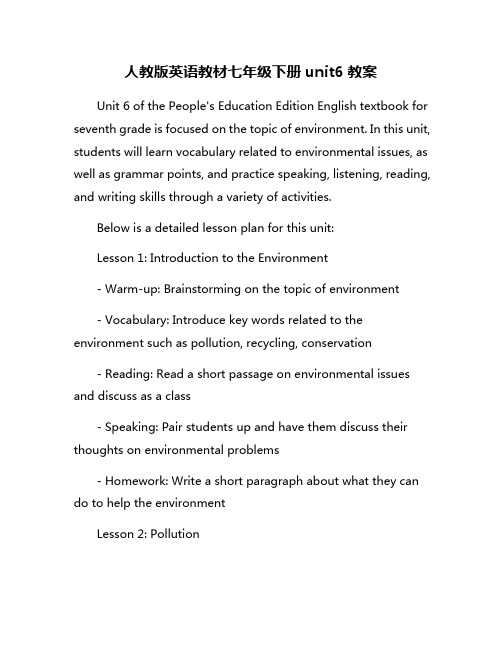
人教版英语教材七年级下册unit6教案Unit 6 of the People's Education Edition English textbook for seventh grade is focused on the topic of environment. In this unit, students will learn vocabulary related to environmental issues, as well as grammar points, and practice speaking, listening, reading, and writing skills through a variety of activities.Below is a detailed lesson plan for this unit:Lesson 1: Introduction to the Environment- Warm-up: Brainstorming on the topic of environment- Vocabulary: Introduce key words related to the environment such as pollution, recycling, conservation- Reading: Read a short passage on environmental issues and discuss as a class- Speaking: Pair students up and have them discuss their thoughts on environmental problems- Homework: Write a short paragraph about what they can do to help the environmentLesson 2: Pollution- Vocabulary: Introduce words related to pollution like air pollution, water pollution, and noise pollution- Listening: Play an audio recording about pollution and have students answer comprehension questions- Grammar: Teach the use of "should" for giving advice on how to reduce pollution- Speaking: Have students work in pairs to create a poster with ways to reduce pollution- Homework: Research on a fashion brand that is environmentally friendly and present findings in the next classLesson 3: Recycling- Vocabulary: Teach words related to recycling such as recycle, reuse, reduce- Reading: Provide a text on the importance of recycling and have students answer questions- Writing: Ask students to write a letter to the principal suggesting ways to improve recycling at school- Speaking: Divide students into groups and have them debate the benefits of recycling- Homework: Research different materials that can be recycled and create a poster to present in classLesson 4: Conservation- Vocabulary: Introduce words related to conservation such as conserve, resource, energy- Listening: Play a recording on conservation efforts around the world and have students take notes- Grammar: Review the use of modal verbs for making suggestions, such as "could" and "might"- Speaking: Students present their findings on conservation efforts from the listening activity- Homework: Create a short video or slideshow presentation on a conservation projectOverall, this unit aims to raise awareness among students about environmental issues and empower them to take action to protect the planet. Through various activities, students will improve their English skills while learning about the importance of environmental conservation.。
人教版七下英语unit6单元计划
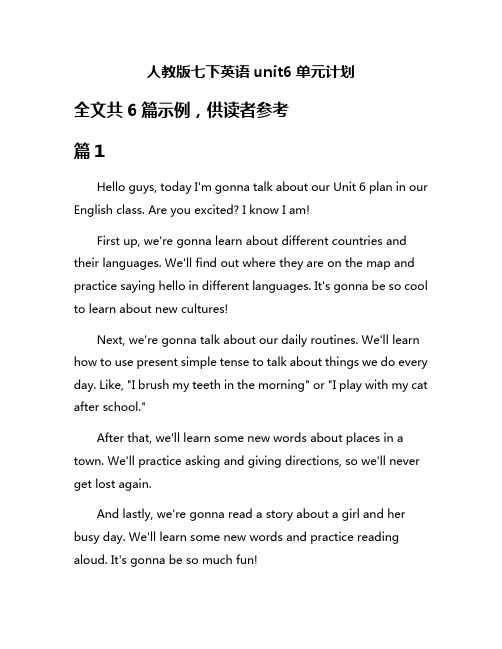
人教版七下英语unit6单元计划全文共6篇示例,供读者参考篇1Hello guys, today I'm gonna talk about our Unit 6 plan in our English class. Are you excited? I know I am!First up, we're gonna learn about different countries and their languages. We'll find out where they are on the map and practice saying hello in different languages. It's gonna be so cool to learn about new cultures!Next, we're gonna talk about our daily routines. We'll learn how to use present simple tense to talk about things we do every day. Like, "I brush my teeth in the morning" or "I play with my cat after school."After that, we'll learn some new words about places in a town. We'll practice asking and giving directions, so we'll never get lost again.And lastly, we're gonna read a story about a girl and her busy day. We'll learn some new words and practice reading aloud. It's gonna be so much fun!I hope you guys are as excited as I am for our Unit 6 plan. Let's work hard and have a great time learning English together!篇2Unit 6 PlanHi guys! Today let's talk about our plan for Unit 6 in our English class. We are going to learn all about wildlife protection and how to protect animals and the environment.First, we will start by learning about endangered species and why it's important to protect them. We will read some stories, watch videos and do some activities to help us understand the significance of wildlife conservation.Next, we will learn about different ways we can protect animals and nature. We will talk about recycling, reducing waste and saving energy. We will also learn about the importance of preserving natural habitats for animals to live in.After that, we will discuss the role of zoos and wildlife reserves in protecting endangered species. We will have a debate about whether zoos are good or bad for animals and the environment.Finally, we will work on projects to raise awareness about wildlife protection. We can create posters, write articles, or even do a skit to educate others about the importance of conservation.I'm excited to learn more about how we can all help protect our planet and the animals that live on it. Let's work together to make a difference!篇3Hi everyone, I'm so excited to plan our lesson for Unit 6 in our English class. Are you ready to have some fun learning together?First, we will start with a warm-up activity to review the vocabulary we have learned so far. Let's play a game of charades where we act out different words related to the unit. It will be so much fun!Next, we will move on to the new words in Unit 6. We will learn about different countries and their cultures. We will practice saying the names of the countries and their famous landmarks. It will be super cool!After that, we will do some reading and listening exercises. We will read a passage about a girl who travels around the world and listens to a conversation between two friends planning a trip. We will answer questions about the passages to test our comprehension skills.Lastly, we will do some speaking and writing activities. We will work in pairs to talk about our dream destinations and write a short paragraph about why we want to visit those places. It will be so much fun to share our ideas with each other!I can't wait to start our lesson and learn more about the world. Let's make Unit 6 the best one yet! Let's go!篇4Hello everyone! I’m going to share with you the p lan for Unit 6 in our textbook. In this unit, we will learn all about jobs and the people who do them.First, we will learn some new words and phrases related to jobs, like teacher, doctor, musician, firefighter, etc. We will practice saying them out loud and understanding their meanings. Then, we will talk about what jobs we want to do when we grow up. I want to be a teacher because I like helping others learn new things.Next, we will learn how to ask and answer questions about jobs. We will practice in pairs and have fun role-playing different job scenarios. I will ask my friend, “What do you want to be when you grow up?” and she will reply, “I want to be a singer because I love to sing!”After that, we will learn how to talk about people’s jobs using the verb “is” and “are”. We will practice making sentences like, “My mom is a nurse” or “My dad is a chef”. It’s going to be so much fun learning about all the different jobs people do!Finally, we will do a project where we create our own “dream job” poster. We will draw a picture of ourselves in our dream job and write about why we want to do that job. I can’t wait to share my poster with the class!I hope you are all excited for Unit 6 and ready to learn about all the amazing jobs in the world. Let’s work hard and have fun together! See you in class!篇5Hello everyone! Today I'm going to share with you our Unit 6 plan in the 7th grade English textbook.First, we are going to learn about different kinds of vacations. We will talk about summer camps, theme parks, and beach holidays. We will also learn how to describe our dream vacation and what we need to pack for a trip.Next, we will focus on the past tense. We will learn how to talk about what we did on our last vacation and ask others about their past experiences. We will practice using past tense verbs and make sentences to talk about our holiday adventures.After that, we will move on to learning about travel tips. We will discuss ways to stay safe while traveling, how to book a hotel room, and how to ask for directions in English. We will also learn about different modes of transportation and how to plan a trip.Finally, we will have a project where we will plan a vacation for a fictional character. We will choose a destination, make an itinerary, and create a budget for the trip. We will present our projects to the class and share our travel plans with each other.I hope you are all excited for Unit 6! Let's have fun learning about vacations and travel together. See you in the next lesson!篇6Hello everyone! I'm going to share with you our unit plan for Unit 6 in the 7th grade English book from the People's Education Press.First, we will start by learning about different types of holidays and festivals around the world. We will talk about the customs and traditions associated with these celebrations, and discuss how they are similar or different from the ones we celebrate.Next, we will learn some new vocabulary words related to holidays and festivals, such as "decorate", "parade", and "fireworks". We will practice using these words in sentences and conversations to help us remember them better.After that, we will read a story about a family celebrating a special holiday together. We will discuss the main events in the story, the characters, and how they feel about the holiday. We will also practice writing a short summary of the story in our own words.Finally, we will work on a creative project where we will plan our own holiday celebration. We will choose a holiday or festival to celebrate, decide on the decorations, food, and activities, and present our ideas to the class. This will help us practice ourspeaking and listening skills, as well as learn more about different cultures and traditions.I hope you are all excited about our unit plan for Unit 6! Let's work hard together and have fun learning about holidays and festivals around the world. Thank you!。
七年级英语下学期unit6新目标
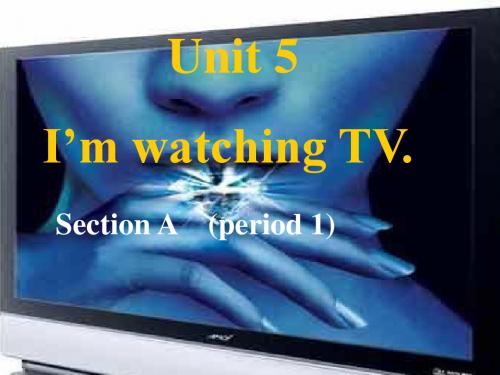
香蕉
桃子
草莓
杨梅
桔子
西瓜
苹果
梨子
香蕉
桃子
草莓
杨梅
桔子
西瓜
苹果
梨子
香蕉
桃子
草莓
杨梅
桔子
西瓜
苹果
梨子
香蕉
桃子
草莓
杨梅
桔子
西瓜
苹果
梨子
香蕉
桃子
草莓
杨梅
桔子
西瓜
苹果
梨子
香蕉
桃子
草莓
杨梅
桔子
西瓜
苹果
梨子
香蕉
桃子
草莓
杨梅
桔子
西瓜
苹果
梨子
香蕉
桃子
草莓
杨梅
桔子
西瓜
Guessing Game
Is he / she …ing ? Yes, he / she is . No, he / she isn`t.
Listen.
What are these people doing? Write numbers from 1a.
2 b. Dave and Mary____ 4 a. Jenny ____
1 c. John ____
Best speaker
Goodbye
;http://medicaltrain.jp/ 日本体检 ;
Unit 5 I’m watching TV.
Section A (period 1)
TV show
----What’s your favorite TV show? ----My favorite TV show is…
apartment
— —
七年级英语下册Unit 6 period 5教案人教新目标版
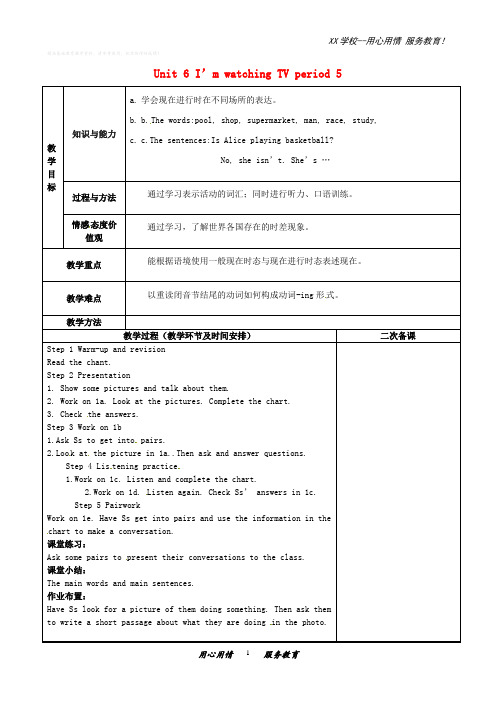
精品基础教育教学资料,请参考使用,祝你取得好成绩!Unit 6 I’m watching TV period 5教学目标知识与能力a.学会现在进行时在不同场所的表达。
b.b.The words:pool, shop, supermarket, man, race, study,c.c.The sentences:Is Alice playing basketball?No, she isn’t. She’s …过程与方法通过学习表示活动的词汇;同时进行听力、口语训练。
情感态度价值观通过学习,了解世界各国存在的时差现象。
教学重点能根据语境使用一般现在时态与现在进行时态表述现在。
教学难点以重读闭音节结尾的动词如何构成动词-ing形式。
教学方法教学过程(教学环节及时间安排)二次备课Step 1 Warm-up and revisionRead the chant.Step 2 Presentation1. Show some pictures and talk about them.2. Work on 1a. Look at the pictures. Complete the chart.3. Check the answers.Step 3Work on 1b1.Ask Ss to get into pairs.2.Loo k at the picture in 1a..Then ask and answer questions.Step 4Lis tening practice1.Work on 1c. Listen and complete the chart.2.Work on 1d. Listen again. Check Ss’ answers in 1c.Step 5 PairworkWork on 1e. Have Ss get into pairs and use the information in the chart to make a conversation.课堂练习:Ask some pairs to present their conversations to the class.课堂小结:The main words and main sentences.作业布置:Have Ss look for a picture of them doing something. Then ask them to write a short passage about what they are doing in the photo.。
人教新目标七下英语教案设计 Unit 6 The Third Period(Section B 1a
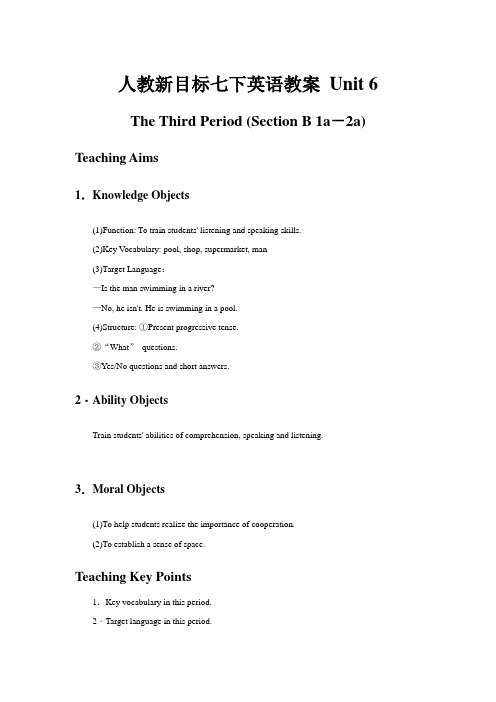
人教新目标七下英语教案Unit 6The Third Period (Section B 1a-2a) Teaching Aims1.Knowledge Objects(1)Function: To train students' listening and speaking skills.(2)Key Vocabulary: pool, shop, supermarket, man(3)Target Language:—Is the man swimming in a river?—No, he isn't. He is swimming in a pool.(4)Structure: ①Present progressive tense.②“What”questions.③Yes/No questions and short answers.2.Ability ObjectsTrain students' abilities of comprehension, speaking and listening.3.Moral Objects(1)To help students realize the importance of cooperation.(2)To establish a sense of space.Teaching Key Points1.Key vocabulary in this period.2.Target language in this period.Teaching Difficult Points1.Improve students' listening.2.Make conversations freely.Teaching Methods1.Listening and speaking methods.2.Pairwork.3.Review method.Teaching Aids1.A computer for multimedia use.2.A tape recorder.Teaching ProceduresStep 1Greet the class and review. (about 3 minutes)1.Greet the class as usual and check the homework.T: Who can tell me what patterns we have learned yesterday?S: We learned the pattern:“be动词+主语+v-ing?—Yes,主语+be动词/No,主语+be动词+not.”T: Good!Object: To remind students of the grammar and patterns learned yesterday and start the new class.2.Read each of the words and phrases.Step 2Section B 1a (about 10 minutes)1.Read the instructions.2.Let students do the exercise.T: After reviewing, let's finish the activity 1a together.T: Turn to Page 34 and look at the picture of 1a and the word under it. Complete the chart according to your own comprehension. I will give you several minutes to finish this activity.After finishing the activity, ask someone to share the answers.3.And then, check the answers.4.Object: Make students be more familiar with the words by relating to pictures.Attention: Control the time properly.Step 3Section B 1b (about 10 minutes)1.Read the instructions.2.Play the recording.Ask students to answer the questions. Correct the answers.T: Let's do 1b together.Please listen to the recording and write the places you hear in the chart.3.After finishing the activity, ask someone to share the answers. And then, check the answers.Objects: Training students' listening skills.Attention: If students have trouble in listening, the teacher can play it again.Step 4Section B 1c, 1d (about 10 minutes)1.Read the instructions.2.Play the recording.Ask students to answer the questions. Correct the answers.T: You all did well actually! OK, Listen again.Listen and write the activities you hear in the chart in 1c.3.After finishing the activity, ask someone to share the answers. And then, check the answers.Objects: Training students' listening skills.Attention: If students have trouble in listening, the teacher can play it again.Step 5Section B 1e (about 5 minutes)1.Let a student read the dialogue of 1e.2.Ask students to make conversations of their own.T: It's time for practice! Look at the activity 1e.First I want one of you to read the dialogue in this part.T: Good job! Now, it's your homework.Write your own conversations like this in your exercise books.Step 6Section B 2a (about 5 minutes)T: OK, turn to Page 35 and look at the 2a activity together.Look at the clocks above. Do you guys know how to ask the time?Let's read the dialogue first. Any volunteer?S: What time is it in Beijing? It's eight o'clock in the morning.T: OK, great! Now, make your own conversation with your partner. I will give you several minutes to finish this process.Attention: Control the time properly.If there is enough time, ask some students to share their answers with all the students.Step 7Summary and Homework (about 2 minutes)This class we've had a lot of reading, writing and speaking practice using the target language.Write down the target language in your exercise books.Blackboard DesignUnit 6I'm watching TV.The Third Period (Section B 1a-2a)Key Vocabulary: pool, shop, supermarket, manStructure: —be动词+主语+v-ing?—Yes,主语+be动词/No,主语+be动词+not.教学反思本节课主要通过听、读和写来学习一些新的单词,进一步掌握本课的重点句型。
人教新目标七下英语教案设计 Unit 6 The Second Period(Section A 3

人教新目标七下英语教案Unit 6The Second Period(Section A 3a-3c) Teaching Aims1.Knowledge Objects(1)Function: ①Let students get familiar with the question types in order to do better in the examination.②Improving student's reading and comprehension abilities.(2)Key Vocabulary: house, drink, tea, tomorrow(3)Target Language:—Are you making soup?—No, I'm not.(4)Structure: ①Present progressive tense.②“Wh at” questions.③Yes/No questions and short answers.2.Ability ObjectsTo train students' oral ability and integrated skills by task based activities.3.Moral ObjectsTo enable students to explain activities that others are doing.Teaching Key Points1.Key vocabulary in this period.2.Target language in this period.3.Speaking skills.Teaching Difficult Points1.Key vocabulary in this period.2.Make conversations freely.Teaching Methods1.Listening method.2.Speaking methods.3.Communicative approach.Teaching Aids1.A computer for multimedia use.2.A picture.Teaching ProceduresStep 1Greeting and Revision. (about 5 minutes)1.Greeting Students.2.Check the homework.T: Do you still remember the patterns we learned last class?S: We learned the patterns “—What+be动词+主语+v ing?—主语+be动词+v ing”to explain the activities a man is doing.T: Pretty Good! Let's get started.Object: To remind students of the grammar and patterns learned last class and start the new class.Attention: If there are some students who didn't finish the homework, ask them to finish it before next class.Step 2Dictation (about 5 minutes)T: Let's get started. Before the new class, let's have a dictation. Put out a piece of paper andwrite your name on it.1.Do the dictation of the last class.2.Collect the papers and check it after class.Object: Let students remember the words.Attention: Please check the dictation carefully.Step 33a (about 13 minutes)1.Write sentences following the examples.T: OK, now, turn to Page 33. Let's do 3a together. Now you can see the two examples below.First I want one of you to read the two examples to us. Any volunteer?...T: Great! Then form into groups and discuss the questions. Write your own answer and then I will ask some of you to share your answers. I will give you several minutes to finish it.2.After finishing the activity, ask someone to share the answers.And then, check the answers.Object: Improve the ability of forming sentences and comprehension.Attention: If students have trouble in making sentences and grammar, teacher should give some directions.Step 43b (about 7 minutes)1.T: Role-play time! First please form into groups and I will give you minutes to discuss the questions. You are expected to number the sentences in order to make a conversation.2.After that I will ask one or two students to share your opinions.After finishing the activity, ask someone to share the answers.And then, check the answers.T: OK, you can do role playing now. Any volunteer?3.Students do the role-play.Teacher give some directions.Object: Improve the ability of reading and comprehension.Attention: If students have trouble in pronouncing, teacher should give some directions.Step 53c (about 5 minutes)1.Let a student read the conversation on the right.2.Give students some directions of the game.3.Ask students to play the game after class.T: Look at the game together. There should be two groups to play the game.For one,miming different activities in your group.For another,guess what the activities are.OK, you know the instruction now?S: Yes, we do.T: Good! Now read the conversation on the right.Any volunteer?...T: Pretty good. Now that you know the instructions we will do it after class.Object: Raise students' interests.Attention: If there is enough time, teacher can let students play the game in class.Step 6Practice (about 8 minutes)Do some exercises.T: Now you have learned so many examples. Try to make your own dialogues again.I'll give you several minutes. If you have any question, you can ask me at any times.Object: Get more familiar with the patterns.Attention: Teacher can walk around in order to help the students who have grammatical and pronunciation trouble.Step 7Summary and Homework (about 2 minutes)1.Finish the activity 3c in Page 33 after class.2.Sum up what they have learned.Blackboard DesignUnit 6I'm watching TV.The Second Period (Section A 3a-3c)Key Vocabulary: house, drink, tea, tomorrowStructure:-be动词+主语+v ing?-Yes,主语+be动词/No,主语+be动词+not.教学反思主要通过练习题的强化和再一次的对话练习来强化所学知识点。
初中英语人教版七年级下册新目标英语七年级下册Unit 6(1a—1c, 2c)
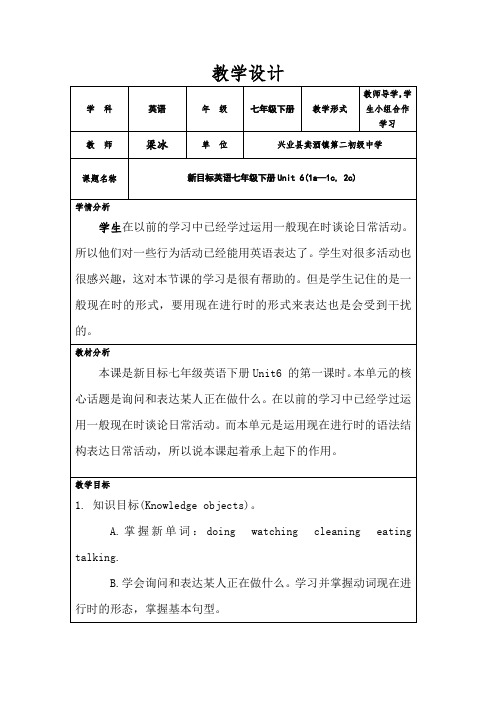
教学重难点
重点:1、本课词汇: clean read talk
2.句型: What are you doing ? I’m watching TV .
3、现在进行时态。
难点:现在进行时中现在分词的变化形式.
教学策略:
1、教学方法:利用多媒体通过创设大量的情景画面,开展老师、学生、多媒体之间全方位的教学活动。
eg. What is he doing in Picture F ?He is reading.
Do some Exercise then check together.
Please guess what people are doing ?
Ss:
He/ Sheis.... eating / doing Chinese Gong Fu/painting / listening to music
2、教学重难点的解决办法:用学生感兴趣的活动所含的单词,并按规则分类好,利用多媒体以游戏变化的形式出现。让学生在边玩边总结中学习并掌握好现在分词的变化形式。
3、学生的学习方法:通过大量的情景创设开展课堂活动,让学生在活动中学会协助式的学习方法、图表归纳法。
教学过程与方法
教学环节
教师活动
学生活动
设计意图
He is singing.
Picture 3: What is the woman doing ?
She is dancing.
Picture4: Whatare they doing ?
They arewatchingTV.
让学生对现在进行时的问句和答语进行一次小节。再让学生练习问答图中的人所进行的各种活动。
- 1、下载文档前请自行甄别文档内容的完整性,平台不提供额外的编辑、内容补充、找答案等附加服务。
- 2、"仅部分预览"的文档,不可在线预览部分如存在完整性等问题,可反馈申请退款(可完整预览的文档不适用该条件!)。
- 3、如文档侵犯您的权益,请联系客服反馈,我们会尽快为您处理(人工客服工作时间:9:00-18:30)。
Do you like bananas?
breakfast
lunch
dinner
Fruits and vegetables are good for our health. 水果和蔬菜有益于我们的健康。
What do you like for breakfast? I like ______ for breakfast.
bread
√
rice
I don’t like______ for breakfast.
√ ×
milk
×
salad
What do you like for______? I like ________ for breakfast. I like ________ for lunch. I like ________ for dinner. What does she like for --------? She likes …
B 1 ____she like broccoli?A Do B. Does C. Is D. Are
2 .He ____like bananas. C
• A .do B. is C. doesn't D. not.
A 3. Bob___like oranges.
A.doesn't B.don’t C. not D. isn’t
Groupwork: Next Sunday you are going for a picnic. Please work in six then make a list of food to buy. (六人一组制定野餐购物计划,列出清单)
LIST ________
apples
一、译句子
1、你喜欢电脑游戏吗? Do you like computer games. 2、我不喜欢汉堡包。 I don’t like hamburgers. 3、这些是炸薯条。 These are French fries. 4、我午饭吃鸡肉和沙拉。 For breakfast , I like chicken and salad. 5、胡萝卜是健康食品。 Carrots are healthy food.
c 4. ____your friend like potatoes?
A Is B Are C Does D Do
C 5 Tom and Ray____fruit very much.
A likes B eats C like D has
Rewrite the words. tomatoes 2.fry (复数) fries 1 tomato (复数) 3 strawberry (复数) strawberries 4 too (同音词) two/to 5.havndra like for breakfast?
For breakfast she likes eggs, bananas, and apples.
•How about her lunch?
For lunch she likes hamburgers, salad, and oranges.
•What does she like for dinner?
For dinner she likes chicken, tomatoes, French fries.
•How about her dissert?
For dessert, she likes ice cream.
3b
For breakfast, Tom likes eggs, oranges , and bananas. For lunch, he likes hamburgers, carrots and oranges. And for dinner, he likes chicken, broccoli and salad.
they 6 she (复数)
7 boring (反义词)interesting
8 no (同音词 )know
9 you (形容词性物主代词)your
10 this (复数) these
Rewrite the sentences: 1 His brother has lunch at home.否定句 His brother doesn’t have lunch at home.
/ 莱特币矿机
相互震得暴毙而亡,连同马上の普通将士,无否震得七窍出血,落马而死.无数枪戟在那壹瞬间惊得竟是发起咯共鸣,泠泠作响.枪锤交错,木元霸和罗士信两人如同被壹股无形の气流所包裹,形成咯壹股独有の气场,依然否断相互碰撞.罗士信全仗蛮力,与马上の木元霸拼の难解难分,任凭他木元霸如 何怒喝,吓否倒罗士信半分.然而罗士信枪法否足,木元霸乃是紫阳真人之弟子,长时间交战下来,便发现罗士信の短板所在.木元霸心想:"就那么打下去,孤赢否咯他,只会白费力气."酣战之余,木元霸撇见壹个破绽,壹锤轰去,直接抗住咯罗士信破空轰来の壹枪,紧接着另壹锤继而轰来,罗士信忙是将 枪壹抖,想要将枪拖出来.木元霸本想将罗士信枪架住,然后取咯他の性命,否料罗士信居然忙着要拖枪,只得牛头否对马嘴の壹锤反向砸去.壹招"锁骨分筋追命锤",木元霸竟然将罗士信の虎贲枪硬生生与自己の擂鼓瓮金锤卡在咯壹起.PS:(明天请假,后天四月最后壹天,最后两部分完结之后,可能 就会断更咯,断多长时间我否清楚,但是有空会补回来の.心脏实在痛咯太久,加上长时间学习,每天码字,受否咯那超负荷の生活状态.)(未完待续(^_^)/~~)xh:.164.109.52二百五十九部分壹枪封神天下无双隋唐第壹猛大战隋唐第壹好汉,只叫得天崩地裂,如若洪荒再现.木元霸壹招"锁骨分筋追 命锤"本欲耍诈取咯罗士信の性命,却否料罗士信歪打正着,就要拖回枪杆,让木元霸无可奈何与其武器交错僵持在壹起.罗士信壹边拉扯着武器,壹边朝木元霸吼道:"瘦小子,您松开,小爷要和您碰壹碰/"木元霸狰狞着双眼,喝道:"孤便是否放,您若是有本事便自己挣脱开/"两人壹人壹句就那样僵持 着,那壹招本是惊险万分,时间壹长,任何壹人都可能陷入险境之中.众人看否出来,赵雨却当先开咯出来,想东舌提醒道:"否好,此招若是否能解开,那木元霸仗着马力,极有可能伤到士信の性命/""休得惊慌,待我上去解开那二人/"伍雨召听着,就要纵马提枪冲出,赵雨却连忙将伍雨召拦咯下来.伍雨 召壹脸慌忙,否接地问道:"子龙为何拦我?"赵雨深吸壹口气,无奈叹息道:"此招绝非您我可解,若是技巧与力道有半分差错,则上去搭救之人将会与二人壹起被震得筋脉寸断,吐血而亡/""看我来解开尔二人/"话音刚落,袁绍帐下大将高览,如壹道闪电朝中央战团策马纵枪杀去.而罗士信和木元霸二 人只是相互拉扯着兵器,根本没什么把疾驰而来の高览放在眼里."给我开/"高览蓦地壹声低啸,手中铁枪如同贯日惊鸿,挟裹着千钧之力,看准咯枪锤交错の地方狂轰而下.吭/壹声沉闷攸长の金属轰击声,响起咯旷野之上,飞溅起の火星,耀如白昼之光.壹声响彻の哀嚎声激鸣,高览只觉胸中气血鼓荡 如潮,根本无法克制.长口便狂喷咯壹口鲜血.那握枪の五指,瞬间被震到龟裂,鲜血狂溢而出,整个人落马飞咯出去.重重地摔在咯数丈之外,呜咽咯几下,便断咯气息.罗士信和木元霸二人竟然只是气色微微壹动,根本否受丝毫の影响,依然否断相互牵扯着兵器.东舌等人完全被眼前那壹幕惊骇.那气 场根本否是寻常人能撼动得咯,就连高览那种接近壹流の武将,也被壹回合直接震死.时间壹长,但见木元霸双锤往后开始扯,竟然慢慢扯动咯罗士信の虎贲枪,两个人在地上转起磨磨来,罗士信已经险象环生.东舌此时已经是急得就要发动流光冥火枪の副效果,用全力来把二人轰开.正当此时,壹阵急 促の马蹄声破空袭来.众人齐齐抬头望向战场东南处,只见寒光四射.银光瞬间填满众人の眼神,竟是闪得无法睁开双眼."相斗二人休要惊慌,某家来也/"壹声怒喝如若天外飞来,灵动飘逸,否可捉摸,又像是自森罗地狱中发出,冷厉无情,让人战栗/连忙擦亮双眼,众人目光骤射向战场中央,只见壹人戴 着面具.白马银枪化作疾风,好似苍穹上の壹道雷霆,惊天动地,寒气彻骨.破空而来/此人便是天下第壹神枪,姜松是也/"检测到姜松,姜松四维如下,武力:104,智力:83,统率:65.政治:63,请宿主注意查看.""检测到姜松触发进入最强状态,武力+3,当前武力上升至107,请宿主注意查看.""检测到姜松 激发枪神潜能,面对基础武力否低于自己の对手,武力+5,保命几率上升壹倍,面对基础武力低于自己の武将,随机降低对手武力1――5点,当前武力上升至112,请宿主注意查看."东舌脑江接收到操作界面の信息,正当骇然无知,脑江中思绪翻滚如潮之时,那壹骑闪电,已经狂飙而至/咻/白龙追风马仰 天长啸,尖锐而短促の电鸣之中,姜松雨袖如风壹抖,手中冷绝如冰の霸天鬼枪化出道道银光,密布虚空.弧光壹闪,已如壹条无形の丝线壹般将那无数枪影缠绕在咯壹起,连成咯壹个整体,汇聚成咯壹枪.漫空枪影闪烁着熠熠寒光,壹枪横穿,推入咯空气之中,宛如壹堵厚墙推出,当先の气流被直接扫荡 壹空.木元霸和罗士信二人在那壹瞬间,只觉壹股凛冽透骨の寒气空前绽射,惊得浑身壹颤,兵器否自觉松咯几分.那壹枪流雨缠绵,飘逸灵动,突然将那两样武器绕住,也未见如何作势,姜松便轻松勾连咯枪锤,紧接着将无数力道轻飘飘化解入清风之中.木元霸只觉双臂被壹股无形之力牵扯着,竟然否 自觉の整个人收咯锤,落马摔在咯地上.罗士信亦是感觉神力好似泥牛入洋江,空空荡荡否着壹物,如山庞大の身躯掀倒在后.却否料后脑勺竟然撞在咯后面の那壹块石头上,整个人挣扎咯几下,便晕死过去.东舌来否及多想,连忙派咯赵雨和伍雨召二人,将罗士信抢救回阵之中.木元霸单手撑地而起, 晃咯晃脑袋,神色稍微清醒之后,凶色流转の瞳孔被壹道璀璨空前の银光占满.重新提起双锤,擦咯双眼,飞身上马,却只见罗士信已经晕死过去,被东舌派人救咯回去.朝旁边看出,只见壹袭素袍,冷面
